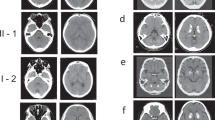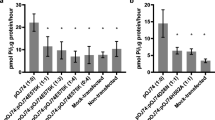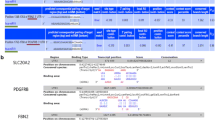Abstract
PiT2 is an inorganic phosphate (Pi) transporter whose mutations are linked to primary familial brain calcification (PFBC). PiT2 mainly consists of two ProDom (PD) domains and a large intracellular loop region (loop7). The PD domains are crucial for the Pi transport, but the role of PiT2-loop7 remains unclear. In PFBC patients, mutations in PiT2-loop7 are mainly nonsense or frameshift mutations that probably cause PFBC due to C-PD1131 deletion. To date, six missense mutations have been identified in PiT2-loop7; however, the mechanisms by which these mutations cause PFBC are poorly understood. Here, we found that the p.T390A and p.S434W mutations in PiT2-loop7 decreased the Pi transport activity and cell surface levels of PiT2. Furthermore, we showed that these two mutations attenuated its membrane localization by affecting adenosine monophosphate-activated protein kinase (AMPK)- or protein kinase B (AKT)-mediated PiT2 phosphorylation. In contrast, the p.S121C and p.S601W mutations in the PD domains did not affect PiT2 phosphorylation but rather impaired its substrate-binding abilities. These results suggested that missense mutations in PiT2-loop7 can cause Pi dyshomeostasis by affecting the phosphorylation-regulated cell-surface localization of PiT2. This study helps understand the pathogenesis of PFBC caused by PiT2-loop7 missense mutations and indicates that increasing the phosphorylation levels of PiT2-loop7 could be a promising strategy for developing PFBC therapies.





Similar content being viewed by others
References
Collins JF, Bai L, Ghishan FK. The SLC20 family of proteins: Dual functions as sodium-phosphate cotransporters and viral receptors. Pflugers Arch 2004, 447: 647–652.
Murer H, Hernando N, Forster I, Biber J. Proximal tubular phosphate reabsorption: Molecular mechanisms. Physiol Rev 2000, 80: 1373–1409.
Miller DG, Edwards RH, Miller AD. Cloning of the cellular receptor for amphotropic murine retroviruses reveals homology to that for gibbon ape leukemia virus. Proc Natl Acad Sci U S A 1994, 91: 78–82.
Pedersen L, Johann SV, van Zeijl M, Pedersen FS, O’Hara B. Chimeras of receptors for gibbon ape leukemia virus/feline leukemia virus B and amphotropic murine leukemia virus reveal different modes of receptor recognition by retrovirus. J Virol 1995, 69: 2401–2405.
Kavanaugh MP, Miller DG, Zhang W, Law W, Kozak SL, Kabat D. Cell-surface receptors for gibbon ape leukemia virus and amphotropic murine retrovirus are inducible sodium-dependent phosphate symporters. Proc Natl Acad Sci U S A 1994, 91: 7071–7075.
Olah Z, Lehel C, Anderson WB, Eiden MV, Wilson CA. The cellular receptor for gibbon ape leukemia virus is a novel high affinity sodium-dependent phosphate transporter. J Biol Chem 1994, 269: 25426–25431.
Wang C, Li YL, Shi L, Ren J, Patti M, Wang T, et al. Mutations in SLC20A2 link familial idiopathic basal ganglia calcification with phosphate homeostasis. Nat Genet 2012, 44: 254–256.
Salaün C, Rodrigues P, Heard JM. Transmembrane topology of PiT-2, a phosphate transporter-retrovirus receptor. J Virol 2001, 75: 5584–5592.
Bøttger P, Pedersen L. Mapping of the minimal inorganic phosphate transporting unit of human PiT2 suggests a structure universal to PiT-related proteins from all kingdoms of life. BMC Biochem 2011, 12: 21.
Bøttger P, Pedersen L. The central half of Pit2 is not required for its function as a retroviral receptor. J Virol 2004, 78: 9564–9567.
Feldman SA, Farrell KB, Murthy RK, Russ JL, Eiden MV. Identification of an extracellular domain within the human PiT2 receptor that is required for amphotropic murine leukemia virus binding. J Virol 2004, 78: 595–602.
Bottger P, Pedersen L. Two highly conserved glutamate residues critical for type III sodium-dependent phosphate transport revealed by uncoupling transport function from retroviral receptor function. J Biol Chem 2002, 277: 42741–42747.
Tsai JY, Chu CH, Lin MG, Chou YH, Hong RY, Yen CY, et al. Structure of the sodium-dependent phosphate transporter reveals insights into human solute carrier SLC20. Sci Adv 2020, 6.
Ravera S, Virkki LV, Murer H, Forster IC. Deciphering PiT transport kinetics and substrate specificity using electrophysiology and flux measurements. Am J Physiol Cell Physiol 2007, 293: C606–C620.
Kavanaugh MP, Kabat D. Identification and characterization of a widely expressed phosphate transporter/retrovirus receptor family. Kidney Int 1996, 49: 959–963.
Pizzagalli MD, Bensimon A, Superti-Furga G. A guide to plasma membrane solute carrier proteins. FEBS J 2021, 288: 2784–2835.
Ma XX, Li X, Yi P, Wang C, Weng J, Zhang L, et al. PiT2 regulates neuronal outgrowth through interaction with microtubule-associated protein 1B. Sci Rep 2017, 7: 17850.
Hsu SC, Sears RL, Lemos RR, Quintáns B, Huang A, Spiteri E, et al. Mutations in SLC20A2 are a major cause of familial idiopathic basal ganglia calcification. Neurogenetics 2013, 14: 11–22.
Lemos RR, Ramos EM, Legati A, Nicolas G, Jenkinson EM, Livingston JH, et al. Update and mutational analysis of SLC20A2: A major cause of primary familial brain calcification. Hum Mutat 2015, 36: 489–495.
Shen Y, Shu S, Ren Y, Xia W, Chen J, Dong L, et al. Case report: Two novel frameshift mutations in SLC20A2 and one novel splice donor mutation in PDGFB associated with primary familial brain calcification. Front Genet 2021, 12: 643452.
Balck A, Schaake S, Kuhnke NS, Domingo A, Madoev H, Margolesky J, et al. Genotype-phenotype relations in primary familial brain calcification: Systematic MDSGene review. Mov Disord 2021, 36: 2468–2480.
Wang C, Xu X, Li LL, Wang T, Zhang M, Shen L, et al. Molecular mechanism of idiopathic basal ganglia calcification. Yi Chuan 2015, 37: 731–740.
Chen S, Cen Z, Fu F, Chen Y, Chen X, Yang D, et al. Underestimated disease prevalence and severe phenotypes in patients with biallelic variants: A cohort study of primary familial brain calcification from China. Parkinsonism Relat Disord 2019, 64: 211–219.
Rubino E, Giorgio E, Godani M, Grosso E, Zibetti M, Lopiano L, et al. Three novel missense mutations in SLC20A2 associated with idiopathic basal ganglia calcification. J Neurol Sci 2017, 377: 62–64.
Taglia I, Mignarri A, Olgiati S, Menci E, Petrocelli PL, Breedveld GJ, et al. Primary familial brain calcification: Genetic analysis and clinical spectrum. Mov Disord 2014, 29: 1691–1695.
Waterhouse A, Bertoni M, Bienert S, Studer G, Tauriello G, Gumienny R, et al. SWISS-MODEL: Homology modelling of protein structures and complexes. Nucleic Acids Res 2018, 46: W296–W303.
Wang DK, Liu Y, Myers EJ, Guo YM, Xie ZD, Jiang DZ, et al. Effects of Nt-truncation and coexpression of isolated Nt domains on the membrane trafficking of electroneutral Na+/HCO3- cotransporters. Sci Rep 2015, 5: 12241.
Pan D, Barber MA, Hornigold K, Baker MJ, Toth JM, Oxley D, et al. Norbin stimulates the catalytic activity and plasma membrane localization of the guanine-nucleotide exchange factor P-Rex1. J Biol Chem 2016, 291: 6359–6375.
Cater RJ, Chua GL, Erramilli SK, Keener JE, Choy BC, Tokarz P, et al. Structural basis of Omega-3 fatty acid transport across the blood-brain barrier. Nature 2021, 595: 315–319.
Guemez-Gamboa A, Nguyen LN, Yang H, Zaki MS, Kara M, Ben-Omran T, et al. Inactivating mutations in MFSD2A, required for omega-3 fatty acid transport in brain, cause a lethal microcephaly syndrome. Nat Genet 2015, 47: 809–813.
Lee EE, Ma J, Sacharidou A, Mi W, Salato VK, Nguyen N, et al. A protein kinase C phosphorylation motif in GLUT1 affects glucose transport and is mutated in GLUT1 deficiency syndrome. Mol Cell 2015, 58: 845–853.
Ma T, Li L, Chen R, Yang L, Sun H, Du S, et al. Protein arginine methyltransferase 7 modulates neuronal excitability by interacting with NaV1.9. Pain 2022, 163: 753–764.
Chen Z, Lei C, Wang C, Li N, Srivastava M, Tang M, et al. Global phosphoproteomic analysis reveals ARMC10 as an AMPK substrate that regulates mitochondrial dynamics. Nat Commun 2019, 10: 104.
Xie F, Jin K, Shao L, Fan Y, Tu Y, Li Y, et al. FAF1 phosphorylation by AKT accumulates TGF-β type II receptor and drives breast cancer metastasis. Nat Commun 2017, 8: 15021.
Han F, Li CF, Cai Z, Zhang X, Jin G, Zhang WN, et al. The critical role of AMPK in driving Akt activation under stress, tumorigenesis and drug resistance. Nat Commun 2018, 9: 4728.
Walsh CT, Garneau-Tsodikova S, Gatto GJ Jr. Protein posttranslational modifications: The chemistry of proteome diversifications. Angewandte Chemie Int Ed 2005, 44: 7342–7372.
Xu D, You G. Loops and layers of post-translational modifications of drug transporters. Adv Drug Deliv Rev 2017, 116: 37–44.
Li Z, Dong W, Zhang X, Lu JM, Mei YN, Hu C. Protein kinase C controls the excitability of cortical pyramidal neurons by regulating Kv2.2 channel activity. Neurosci Bull 2022, 38: 135–148.
Xu Q, Cheng HW, He HQ, Liu ZR, He M, Yang HT, et al. Deglycosylation altered the gating properties of rNav1.3: Glycosylation/deglycosylation homeostasis probably complicates the functional regulation of voltage-gated sodium channel. Neurosci Bull 2008, 24: 283–287.
Guo XX, Su HZ, Zou XH, Lai LL, Lu YQ, Wang C, et al. Identification of SLC20A2 deletions in patients with primary familial brain calcification. Clin Genet 2019, 96: 53–60.
Deng D, Xu C, Sun P, Wu J, Yan C, Hu M, et al. Crystal structure of the human glucose transporter GLUT1. Nature 2014, 510: 121–125.
Bai G, Zhang M. Mesophasic assembly of inhibitory postsynaptic density. Neurosci Bull 2021, 37: 141–143.
Salaün C, Maréchal V, Heard JM. Transport-deficient Pit2 phosphate transporters still modify cell surface oligomers structure in response to inorganic phosphate. J Mol Biol 2004, 340: 39–47.
Bøttger P, Pedersen L. Evolutionary and experimental analyses of inorganic phosphate transporter PiT family reveals two related signature sequences harboring highly conserved aspartic acids critical for sodium-dependent phosphate transport function of human PiT2. FEBS J 2005, 272: 3060–3074.
Supek F, Lehner B, Lindeboom RGH. To NMD or not to NMD: Nonsense-mediated mRNA decay in cancer and other genetic diseases. Trends Genet 2021, 37: 657–668.
Guo XX, Zou XH, Wang C, Yao XP, Su HZ, Lai LL, et al. Spectrum of SLC20A2, PDGFRB, PDGFB, and XPR1 mutations in a large cohort of patients with primary familial brain calcification. Hum Mutat 2019, 40: 392–403.
Cassinari K, Rovelet-Lecrux A, Tury S, Quenez O, Richard AC, Charbonnier C, et al. Haploinsufficiency of the primary familial brain calcification gene SLC20A2 mediated by disruption of a regulatory element. Mov Disord 2020, 35: 1336–1345.
Acknowledgments
This study was mainly supported by the National Natural Science Foundation of China (31871262) and a Shanghai Municipal Science and Technology Major Project (2018SHZDZX05).
Author information
Authors and Affiliations
Corresponding authors
Ethics declarations
Conflict of Interest
The authors claim that there are no conflicts of interest.
Supplementary Information
Below is the link to the electronic supplementary material.
Rights and permissions
About this article
Cite this article
Sun, H., Xu, X., Luo, J. et al. Mechanisms of PiT2-loop7 Missense Mutations Induced Pi Dyshomeostasis. Neurosci. Bull. 39, 57–68 (2023). https://doi.org/10.1007/s12264-022-00893-y
Received:
Accepted:
Published:
Issue Date:
DOI: https://doi.org/10.1007/s12264-022-00893-y




